To date, science knows about 3000 species of cichlids that live on almost all continents. More than half of them live on the African continent.
General information
African cichlids can rightfully be called the most colorful freshwater fish. There is no such color variety in any group. The maximum number of species is found primarily in the two African Great Lakes – Malawi (Nyasa) and Tanganyika. These very ancient tectonic lakes have become a real polygon for speciation. The relative isolation and special habitats have resulted in a wide variety of fish groups from several original species.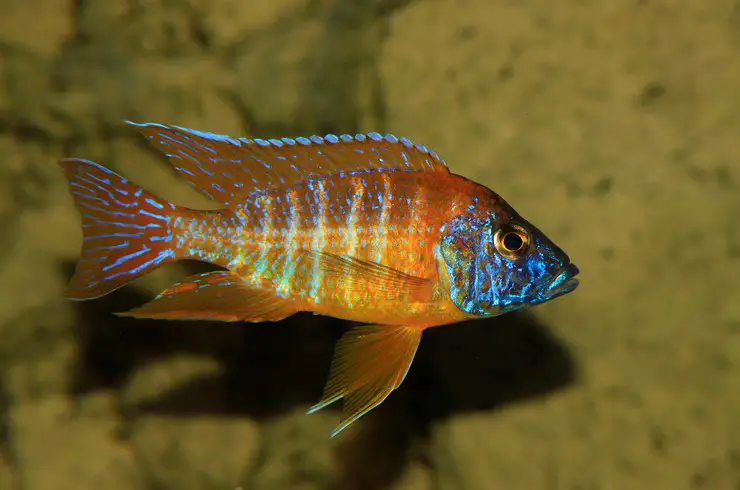
Appearance
African cichlids are very different in appearance. Most often they have an elongated, dense body. The anal and dorsal fins are well developed; in males, they are usually very long. For some species (for example, frontosis), the presence of a fatty outgrowth on the head is characteristic.
The color of most species is bright and catchy. This allows African cichlids to identify their cichlids from afar. First of all, the high decorative qualities of African cichlids and are appreciated by aquarists around the world. In addition to natural colors, breeders have obtained unique color variations that can only be found in an aquarium.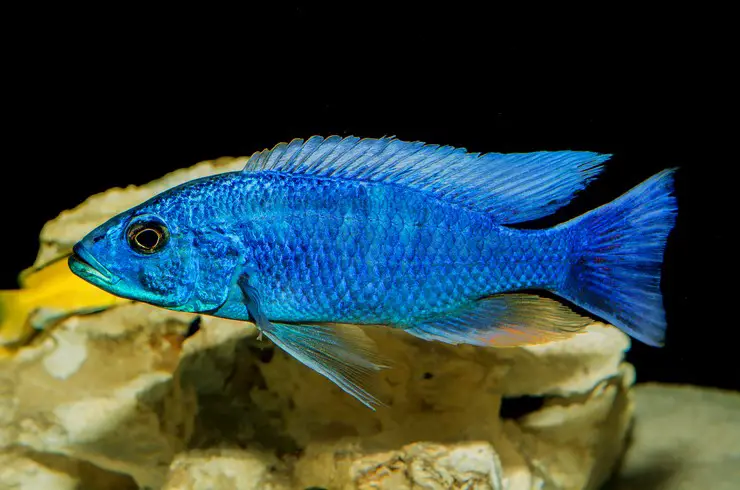
Habitat
Most of the African cichlid species are concentrated in the eastern part of the continent. Their especially great variety can be found in the African Great Lakes – Malawi (Nyasa), Tanganyika, Victoria, etc. Many species are endemic and do not live in other parts of the world. In addition to lake species, there are also river species. It is believed that African cichlids are descended from migratory marine fish, which is indirectly confirmed by the ability of some species to tolerate increased salinity.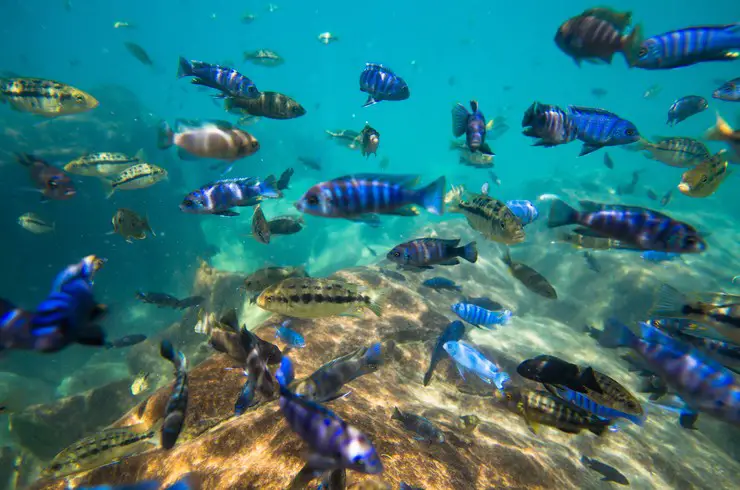
Care and maintenance
Most African cichlids are large in size, so large aquariums are needed to keep these fish – from 100-250 liters per pair. Fish prefer clean water, rich in oxygen, so it is necessary to organize high-quality filtration and aeration. It is better to use large pebbles as soil. This is due to the fact that many African cichlids like to dig the ground and, inadvertently, can swallow small stones. When decorating an aquarium, natural stones are often used that imitate natural rock biotopes. It is necessary to create a large number of shelters so that weaker individuals can hide from the attacks of more aggressive neighbors.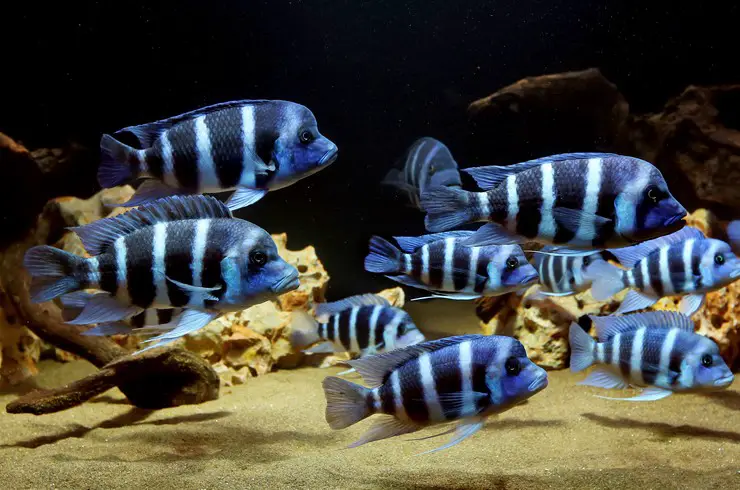
Natural habitats of fish are located in the tropical zone, therefore African cichlids are thermophilic. The temperature in the aquarium should be kept between 24-27 ° C. The parameters of the water in the lakes are different, therefore, to create comfortable conditions, it is necessary to know the origin of a particular species.
When keeping African cichlids, you should not neglect weekly water changes, they should be up to 30% of the volume of the aquarium.
African cichlids are poorly compatible with living plants. They will constantly nibble the leaves and dig in the roots. If you still have a desire to have natural greens, then it is better to pay attention to various types of anubias (hard-leaved plants that can grow without planting in the ground).
Cichlids of African lakes are the most popular fish when decorating a pseudo-sea aquarium.
Compatibility
Cichlids of African lakes are very territorial fish. This point must be taken into account when selecting neighbors for a common aquarium.
Almost all cichlids of Lake Malawi are compatible with each other, but a number of rules must be observed when keeping:
- First, you need to provide sufficient tank volume and plenty of shelters.
- Secondly, you can keep together fish of approximately the same size, since large specimens can offend juveniles.
- Third, Malawians must be kept in pairs or in groups with a predominance of females.
- Finally, this group of cichlids should not be chosen as neighbors for fish from Lake Tanganyika and South America, due to the different conditions of detention.
Unfortunately, even these rules do not give a 100% guarantee of the coexistence of species, because each fish has high intelligence and a unique character, so predicting its behavior is a very difficult task.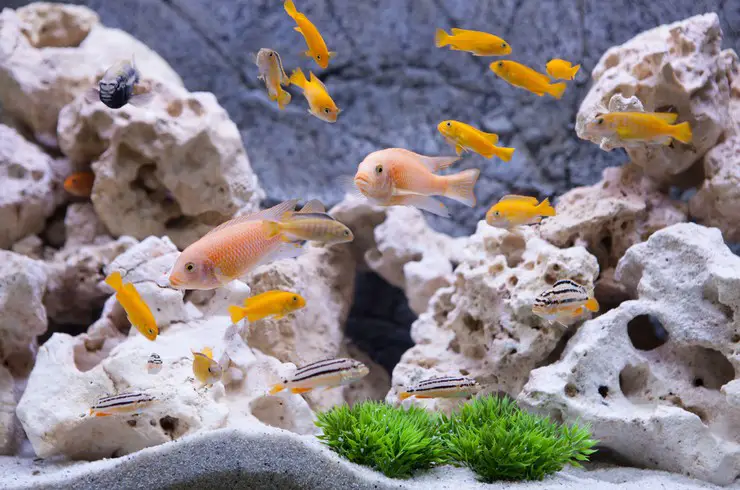
Some members of other families may also coexist with African cichlids in a community aquarium. For example, frequent guests in cichlids: shark barbs, large labels, large catfish (pterygoplicht, cynodonts, etc.)
Accordingly, small species as well as shrimp are more likely to become live food for popular cichlids.
An example of a fairly calm African cichlid is the lemon labidochromis (yellow cichlid, hummingbird cichlid). This peaceful species get along well with peaceful medium-sized fish and shows high aggression only during spawning.
Feeding
Proper feeding of African cichlids depends on the specific species. Among such a heterogeneous group, one can find both predators eating other fish, mollusks and worms, and vegetarians (Malawian cichlids of the Mbuna group). It is necessary to select food for pets depending on their type of food. Quality dry food from Tetra is the best choice for cichlids. All of them are complete and balanced, created from quality raw materials, and take into account the nutritional characteristics of individual groups of fish. The Tetra Cichlid line of feeds will allow you to easily select the necessary ratio for various types of African cichlids since it is produced in different forms: flakes, chips, granules, sticks. Tetra Malawi, a food with a high content of spirulina algae, has been specially developed for Malawian cichlids.
Breeding
Breeding most species of African cichlids in an aquarium is easy. Moreover, spontaneous spawning in a general aquarium while creating comfortable conditions is not at all uncommon. Perhaps, difficulties can arise only with neighbors in the aquarium, because during the spawning period even the most peaceful species of cichlids turn into aggressive creatures, furiously guarding their offspring.
Usually, eggs are deposited on any flat surface: stones, plant leaves, a glass of the aquarium. Laprologus fish lay eggs only in empty shells of gastropods, therefore, to breed these fish in an aquarium, it will be necessary to stock up on shells. Many African cichlids carry offspring in the mouth. Here she develops completely safe from enemies. The fish have a very developed parental instinct. There are cases when individual couples stole eggs from neighboring species and took care of them.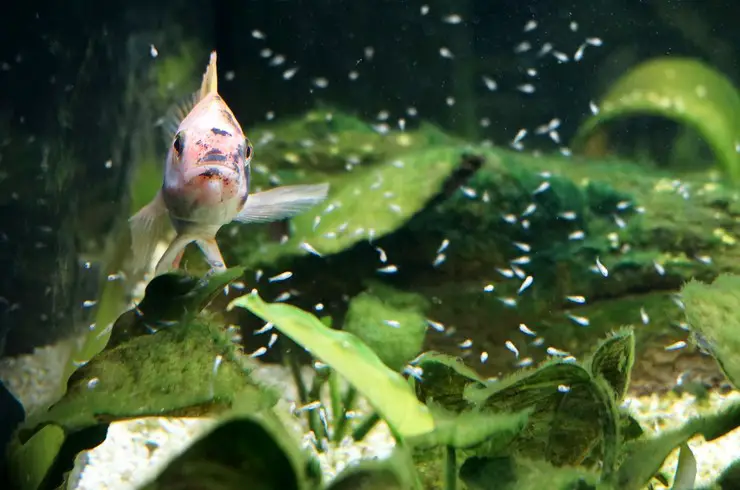
After the appearance of fry, the instinct does not fade away, and for some time the fry continues to hide in the female’s mouth at the first sign of danger.
Many African cichlids are monogamous and form stable pairs for life. Individual species (lamprologus) often live in communities. Several generations of fish get along well with each other, which begin to create their families and settle nearby.
Fry cannibalism is a common occurrence among cichlids, so as the fish grows, it is necessary to sort by size.
